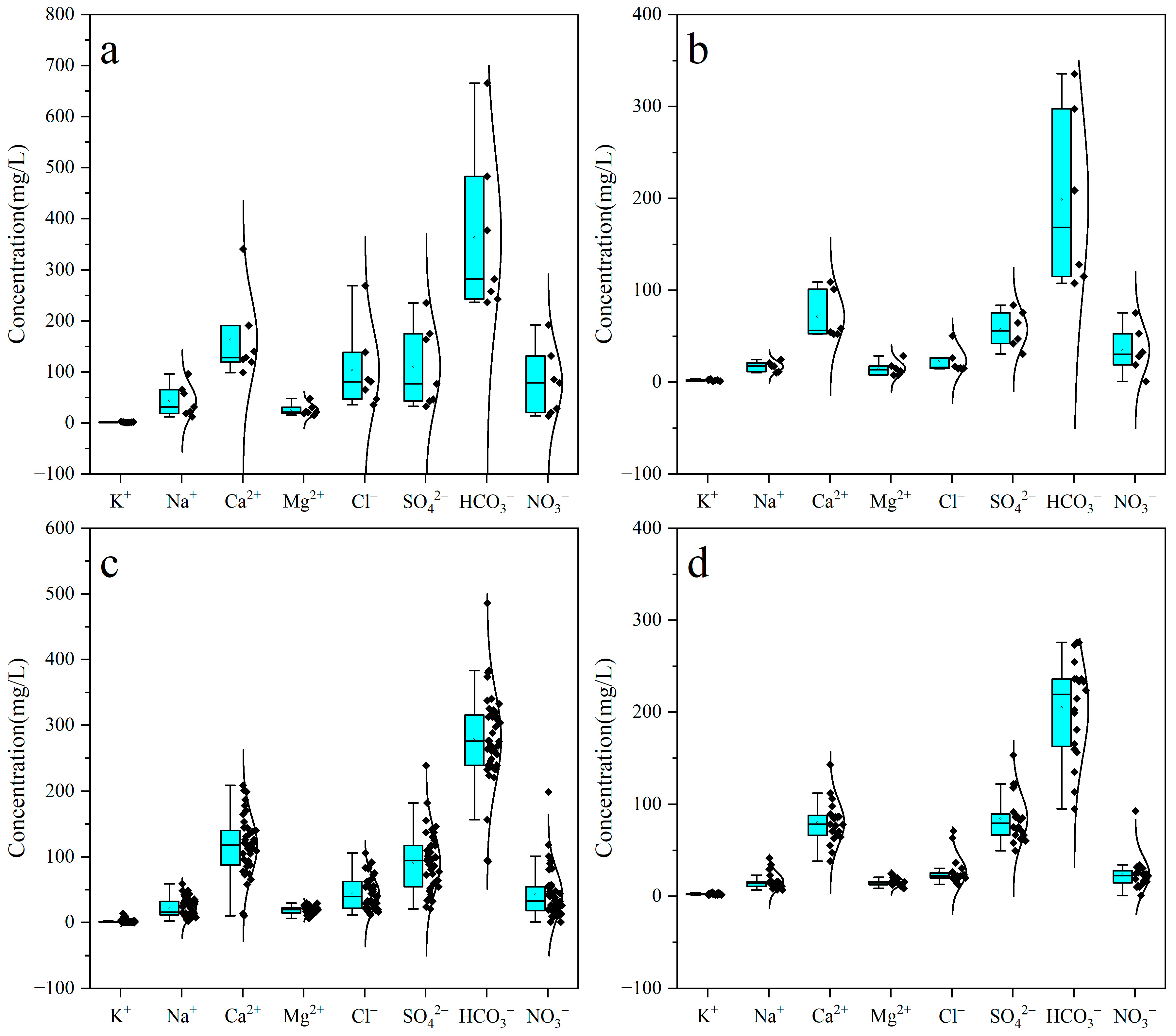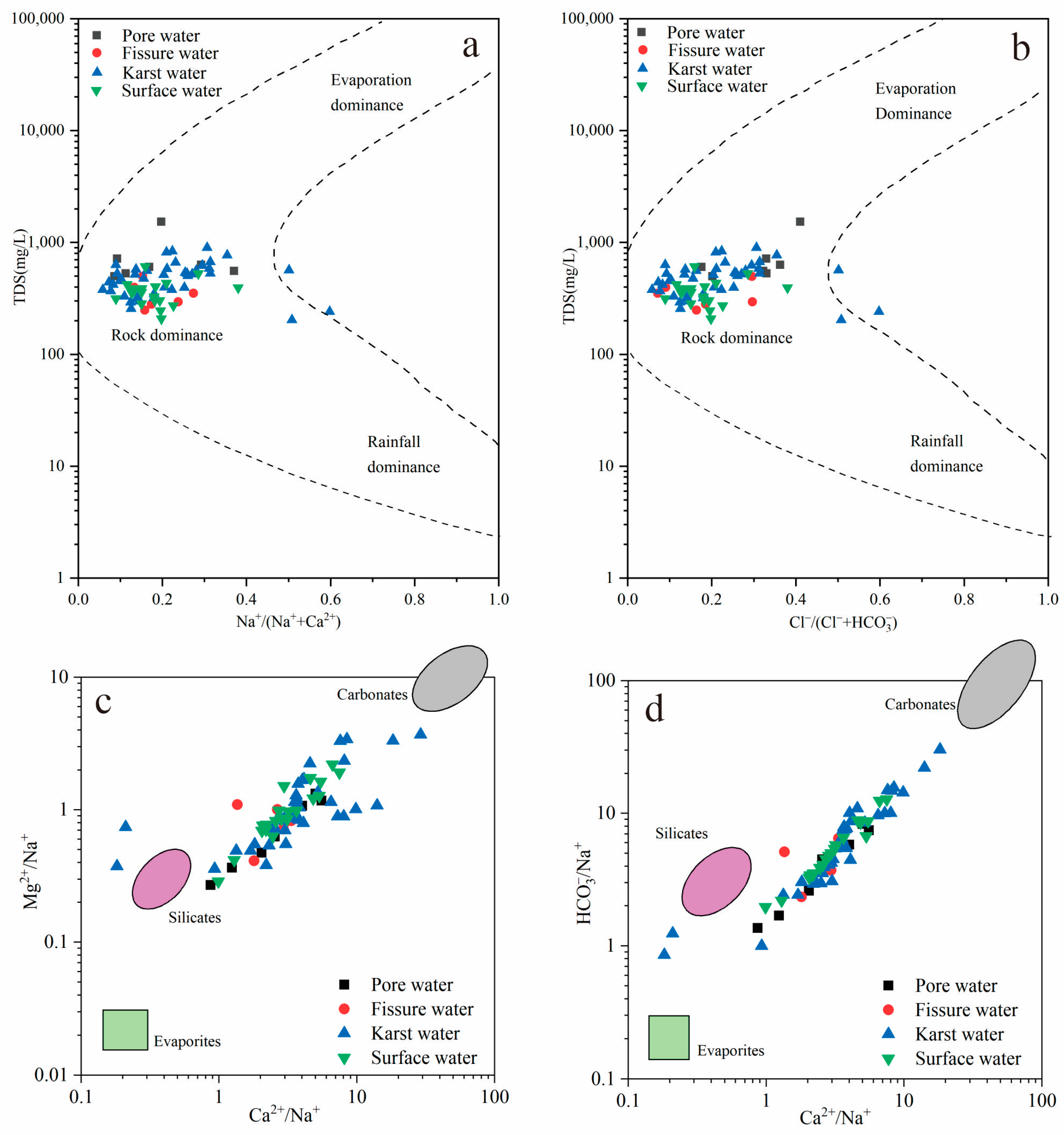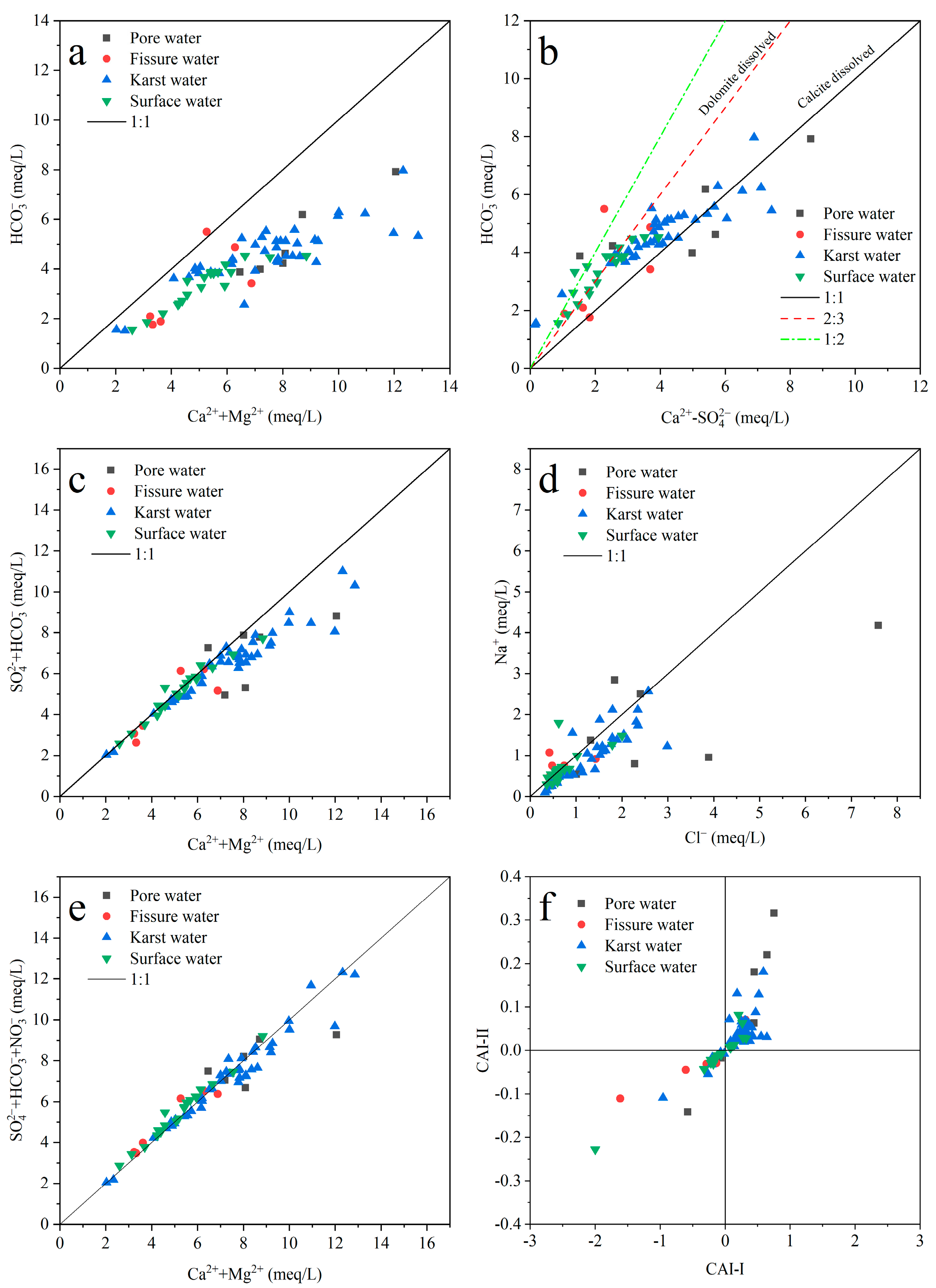Hydrogeochemical Characteristics and Evolution Processes of Karst Groundwater Affected by Multiple Influencing Factors in a Karst Spring Basin, Eastern China
Abstract
:1. Introduction
2. Materials and Methods
2.1. Description of the Study Area
2.2. Sample Collection and Measurements
3. Results and Discussion
3.1. Characteristics of Major Chemical Components
3.2. Hydrogeochemical Type
3.3. Water–Rock Interaction
3.4. REDOX Action
3.5. Cation Exchange
3.6. Anthropogenic Activity
4. Conclusions
Author Contributions
Funding
Data Availability Statement
Acknowledgments
Conflicts of Interest
References
- Ford, D.; Williams, P. Karst Hydrogeology and Geomorphology; John Wiley & Sons: Chichester, UK, 2007. [Google Scholar]
- Laveti, N.V.S.; Banerjee, A.; Kartha, S.A.; Dutta, S. Anthropogenic influence on monthly groundwater utilization in an irrigation dominated Ganga river Sub-Basin. J. Hydrol. 2021, 593, 125800. [Google Scholar] [CrossRef]
- Wang, S.; Lee, C.; Yeh, C.; Choo, Y.F.; Tseng, H. Evaluation of Climate Change Impact on Groundwater Recharge in Groundwater Regions in Taiwan. Water 2021, 13, 1153. [Google Scholar] [CrossRef]
- Liu, Z.; Feng, S.; Zhang, D.; Han, Y.; Cao, R. Effects of precipitation, irrigation, and exploitation on groundwater geochemical evolution in the people’s victory canal irrigation area, China. Appl. Water Sci. 2023, 13, 1. [Google Scholar] [CrossRef]
- He, K.; Jia, Y.; Wang, F.; Lu, Y. Overview of karst geo-environments and karst water resources in north and south China. Environ. Earth Sci. 2011, 64, 1865–1873. [Google Scholar] [CrossRef]
- Liang, Y.; Gao, X.; Zhao, C.; Tang, C.; Shen, H.; Wang, Z.; Wang, Y. Review: Characterization, evolution, and environmental issues of karst water systems in Northern China. Hydrogeol. J. 2018, 26, 1371–1385. [Google Scholar] [CrossRef]
- Shen, H.; Xu, Y.; Liang, Y.; Zhao, C.; Wang, Z.; Zhang, Z.; Qi, J. Review: Groundwater recharge estimation in northern China karst regions. Carbonates Evaporites 2023, 38, 16. [Google Scholar] [CrossRef]
- Moore, P.J.; Martin, J.B.; Screaton, E.J. Geochemical and statistical evidence of recharge, mixing, and controls on spring discharge in an eogenetic karst aquifer. J. Hydrol. 2009, 376, 443–455. [Google Scholar] [CrossRef]
- Newman, C.P.; Paschke, S.S.; Keith, G. Natural and Anthropogenic Geochemical Tracers to Investigate Residence Times and Groundwater–Surface-Water Interactions in an Urban Alluvial Aquifer. Water 2021, 13, 871. [Google Scholar] [CrossRef]
- Gibbs, R.J. Mechanisms controlling world water chemistry. Science 1970, 170, 1088–1090. [Google Scholar] [CrossRef]
- Apollaro, C.; Marini, L.; De Rosa, R.; Settembrino, P.; Scarciglia, F.; Vecchio, G. Geochemical features of rocks, stream sediments, and soils of the Fiume Grande Valley (Calabria, Italy). Environ. Geol. 2007, 52, 719–729. [Google Scholar] [CrossRef]
- Wang, W.; Chena, Y.; Chena, Y.; Wanga, W.; Zhang, T.; Qin, J. Groundwater dynamic influenced by intense anthropogenic activities in a dried-up river oasis of Central Asia. Hydrol. Res. 2022, 53, 532. [Google Scholar] [CrossRef]
- Stigter, T.Y.; Miller, J.; Chen, J.; Re, V. Groundwater and climate change: Threats and opportunities. Hydrogeol. J. 2023, 31, 7–10. [Google Scholar] [CrossRef]
- Owor, M.; Muwanga, A.; Tindimugaya, C.; Taylor, R.G. Hydrogeochemical processes in groundwater in Uganda: A national-scale analysis. J. Afr. Earth Sci. 2021, 175, 104113. [Google Scholar] [CrossRef]
- Yuan, H.; Yang, S.; Wang, B. Hydrochemistry characteristics of groundwater with the influence of spatial variability and water flow in Hetao Irrigation District, China. Environ. Sci. Pollut. Res. 2022, 29, 71150–71164. [Google Scholar] [CrossRef] [PubMed]
- Apollaro, C.; Fuoco, I.; Gennaro, E.; Giuliani, L.; Iezzi, G.; Marini, L.; Radica, F.; Di Luccio, F.; Ventura, G.; Vespasiano, G. Advanced argillic alteration at Cave di Caolino, Lipari, Aeolian Islands (Italy): Implications for the mitigation of volcanic risks and the exploitation of geothermal resources. Sci. Total Environ. 2023, 889, 164333. [Google Scholar] [CrossRef] [PubMed]
- Walraevens, K.; Bakundukize, C.; Mtoni, Y.E.; Van Camp, M. Understanding the hydrogeochemical evolution of groundwater in Precambrian basement aquifers: A case study of Bugesera region in Burundi. J. Geochem. Explor. 2018, 188, 24–42. [Google Scholar] [CrossRef]
- Liu, J.; Wang, H.; Jin, D.; Xu, F.; Zhao, C. Hydrochemical characteristics and evolution processes of karst groundwater in Carboniferous Taiyuan formation in the Pingdingshan coalfield. Environ. Earth Sci. 2020, 79, 151. [Google Scholar] [CrossRef]
- Zhang, Z.; Wang, W.; Qu, S.; Huang, Q.; Liu, S.; Xu, X.; Ni, L. A New Perspective to Explore the Hydraulic Connectivity of Karst Aquifer System in Jinan Spring Catchment, China. Water 2018, 10, 1368. [Google Scholar] [CrossRef]
- Liu, W.; Zhang, L.; Liu, P.; Qin, X.; Shan, X.; Yao, X. FDOM Conversion in Karst Watersheds Expressed by Three-Dimensional Fluorescence Spectroscopy. Water 2018, 10, 1427. [Google Scholar] [CrossRef]
- Luo, Q.; Yang, Y.; Qian, J.; Wang, X.; Chang, X.; Ma, L.; Li, F.; Wu, J. Spring protection and sustainable management of groundwater resources in a spring field. J. Hydrol. 2020, 582, 124498. [Google Scholar] [CrossRef]
- Jiang, A.; Liu, Y.; Yi, S.; Guo, Z.; Cui, Y.; Huang, Q.; Li, J.; Liu, K.; Qiu, M.; Jin, X. Impact of artificial recharge on groundwater and springs: Jinan, China, case study. Arab. J. Geosci. 2021, 14, 111. [Google Scholar] [CrossRef]
- Sun, K.; Hu, L.; Liu, X. The influences of sponge city construction on spring discharge in Jinan city of China. Hydrol. Res. 2020, 51, 959–975. [Google Scholar] [CrossRef]
- Deng, X.; Xing, L.; Zhang, F.; Xing, X.; Zhang, Y.; Yu, M.; Liu, S.; Pan, W. Mapping regional and nested flow systems in the karst aquifers of Jinan spring using hydrochemical and isotope data. Water Supply 2023, 23, 3323. [Google Scholar] [CrossRef]
- Kang, F.; Jin, M.; Qin, P. Sustainable yield of a karst aquifer system: A case study of Jinan springs in northern China. Hydrogeol. J. 2011, 19, 851–863. [Google Scholar] [CrossRef]
- Xi, D.; Sun, B.; Qin, P. Reasearch on Jinan Spring; Jinan Press: Jinan, China, 2017. [Google Scholar]
- Guo, Y.; Qin, D.; Sun, J.; Li, L.; Huang, J. Recharge of River Water to Karst Aquifer Determined by Hydrogeochemistry and Stable Isotopes. Water 2019, 11, 479. [Google Scholar] [CrossRef]
- Wang, J.; Jin, M.; Jia, B.; Kang, F. Hydrochemical characteristics and geothermometry applications of thermal groundwater in northern Jinan, Shandong, China. Geothermics 2015, 57, 185–195. [Google Scholar] [CrossRef]
- Guo, F.; Guo, J.; Wang, C.; Fan, W.; Li, C.; Zhao, L.; Li, H.; Li, J. Formation of mafic magmas through lower crustal AFC processes—An example from the Jinan gabbroic intrusion in the North China Block. Lithos 2013, 179, 157–174. [Google Scholar] [CrossRef]
- Meng, Q.; Xing, L.; Liu, L.; Xing, X.; Zhao, Z.; Zhang, F.; Li, C. Time-lag characteristics of the response of karst springs to precipitation in the northern China. Environ. Earth Sci. 2021, 80, 348. [Google Scholar] [CrossRef]
- Wang, J.; Jin, M.; Lu, G.; Zhang, D.; Kang, F.; Jia, B. Investigation of discharge-area groundwaters for recharge source characterization on different scales: The case of Jinan in northern China. Hydrogeol. J. 2016, 24, 1723–1737. [Google Scholar] [CrossRef]
- Zhang, Z.; Wang, W. Managing aquifer recharge with multi-source water to realize sustainable management of groundwater resources in Jinan, China. Environ. Sci. Pollut. Res. 2021, 28, 10872–10888. [Google Scholar] [CrossRef]
- Piper, A.M. A graphic procedure in the geochemical interpretation of water-analyses. Eos Trans. Am. Geophys. Union 1944, 25, 914–928. [Google Scholar] [CrossRef]
- Wang, M.; Zhang, W.; Yang, P.; Feng, J.; Zhang, R.; Gao, Z.; Jin, H.; Song, X.; Gao, X. Hydrogeochemical Characteristics, Water Quality, and Human Health Risks of Groundwater in Wulian, North China. Water 2023, 13, 359. [Google Scholar] [CrossRef]
- Qu, S.; Liao, F.; Wang, G.; Wang, X.; Shi, Z.; Liang, X.; Duan, L.; Liu, T. Hydrochemical evolution of groundwater in overburden aquifers under the influence of mining activity: Combining hydrochemistry and groundwater dynamics analysis. Environ. Earth Sci. 2023, 85, 135. [Google Scholar] [CrossRef]
- Yang, Y.; Mei, A.; Gao, S.; Zhao, D. Both natural and anthropogenic factors control surface water and groundwater chemistry and quality in the Ningtiaota coalfield of Ordos Basin, Northwestern China. Environ. Sci. Pollut. Res. 2023, 30, 67227–67249. [Google Scholar] [CrossRef] [PubMed]
- Yang, F.; Liu, S.; Jia, C.; Gao, M.; Chang, W.; Wang, Y. Hydrochemical characteristics and functions of groundwater in southern Laizhou Bay based on the multivariate statistical analysis approach. Estuar. Coast. Shelf Sci. 2021, 250, 107153. [Google Scholar] [CrossRef]
- Zhang, X.; Zhao, R.; Wu, X.; Mu, W. Hydrogeochemistry, identification of hydrogeochemical evolution mechanisms, and assessment of groundwater quality in the southwestern Ordos Basin, China. Environ. Sci. Pollut. Res. 2022, 29, 901–921. [Google Scholar] [CrossRef] [PubMed]
- Gaillardet, J.; Dupré, B.; Louvat, P.; Allegre, C.J. Global silicate weathering and CO2 consumption rates deduced from the chemistry of large rivers. Chem. Geol. 1999, 159, 3–30. [Google Scholar] [CrossRef]
- Zhang, H.; Yang, Y.; Qi, H.; Lu, Y.; Yu, T. Hydrochemical evolution of rare cold mineral waters in the Wudalianchi UNESCO Global Geopark, China. Environ. Earth Sci. 2018, 77, 360. [Google Scholar] [CrossRef]
- Sae-Ju, J.; Chotpantarat, S.; Thitimakorn, T. Hydrochemical, geophysical and multivariate statistical investigation of the seawater intrusion in the coastal aquifer at Phetchaburi Province, Thailand. J. Asian Earth Sci. 2020, 191, 104165. [Google Scholar] [CrossRef]
- Khan, A.F.; Srinivasamoorthy, K.; Prakash, R.; Rabina, C. Hydrochemical and statistical techniques to decode groundwater geochemical interactions and saline water intrusion along the coastal regions of Tamil Nadu and Puducherry, India. Environ. Geochem. Health 2021, 43, 1051–1067. [Google Scholar] [CrossRef]
- Schoeller, H. Qualitative evaluation of groundwater resources. Methods Tech. Groundw. Investig. Dev. UNESCO Water Resour. Ser. 1965, 33, 44–52. [Google Scholar]
- Resz, M.A.; Roman, C.; Senila, M.; Török, A.I.; Kovacs, E. A Comprehensive Approach to the Chemistry, Pollution Impact and Risk Assessment of Drinking Water Sources in a Former Industrialized Area of Romania. Water 2023, 15, 1180. [Google Scholar] [CrossRef]
- Wakida, F.T.; Lerner, D.N. Non-agricultural sources of groundwater nitrate: A review and case study. Water Res. 2005, 39, 3–16. [Google Scholar] [CrossRef]
- Roy, S.; Gaillardet, J.; Allegre, C.J. Geochemistry of dissolved and suspended loads of the Seine river, France: Anthropogenic impact, carbonate and silicate weathering. Geochim. Cosmochim. Acta 1999, 63, 1277–1292. [Google Scholar] [CrossRef]
- Fan, B.; Zhao, Z.; Tao, F.; Liu, B.; Tao, Z.; Gao, S.; Zhang, L. Characteristics of carbonate, evaporite and silicate weathering in Huanghe River basin: A comparison among the upstream, midstream and downstream. J. Asian Earth Sci. 2014, 96, 14–26. [Google Scholar] [CrossRef]
- Liu, J.; Peng, Y.; Li, C.; Gao, Z.; Chen, S. An investigation into the hydrochemistry, quality and risk to human health of groundwater in the central region of Shandong Province, North China. J. Clean. Prod. 2021, 282, 125416. [Google Scholar] [CrossRef]






| Water Type | Parameters | pH | TDS mg/L | mg/L | mg/L | mg/L | mg/L | mg/L | mg/L | mg/L | mg/L |
|---|---|---|---|---|---|---|---|---|---|---|---|
| Surface water | Min | 7.60 | 209.04 | 1.36 | 6.74 | 38.00 | 8.46 | 12.70 | 49.50 | 95.03 | 0.77 |
| Max | 8.20 | 609.59 | 4.07 | 41.20 | 143.00 | 24.40 | 70.90 | 153.00 | 275.91 | 92.70 | |
| Mean | 7.97 | 364.62 | 2.44 | 16.31 | 80.08 | 15.14 | 26.23 | 84.47 | 204.94 | 23.83 | |
| SD | 0.18 | 92.80 | 0.81 | 8.98 | 23.55 | 4.25 | 15.00 | 25.99 | 53.32 | 18.33 | |
| CV | 0.02 | 0.25 | 0.33 | 0.55 | 0.29 | 0.28 | 0.57 | 0.31 | 0.26 | 0.77 | |
| Pore water | Min | 7.40 | 499.10 | 0.34 | 12.30 | 52.59 | 15.30 | 35.70 | 32.70 | 236.05 | 14.00 |
| Max | 7.80 | 1533.47 | 2.36 | 95.90 | 76.55 | 48.10 | 269.00 | 235.00 | 665.24 | 192 | |
| Mean | 7.59 | 724.00 | 1.21 | 43.27 | 67.02 | 25.24 | 102.97 | 110.16 | 363.42 | 78.50 | |
| SD | 0.13 | 364.10 | 0.81 | 30.65 | 8.51 | 11.12 | 80.32 | 79.95 | 160.26 | 65.52 | |
| CV | 0.02 | 0.50 | 0.66 | 0.71 | 0.13 | 0.44 | 0.78 | 0.73 | 0.44 | 0.83 | |
| Fissure water | Min | 6.90 | 248.48 | 0.89 | 10.20 | 52.20 | 7.53 | 14.50 | 30.50 | 107.30 | 0.66 |
| Max | 7.60 | 497.72 | 3.55 | 24.70 | 109.00 | 28.60 | 50.70 | 83.80 | 335.73 | 75.40 | |
| Mean | 7.27 | 345.08 | 1.96 | 17.00 | 71.25 | 14.76 | 23.12 | 57.20 | 198.64 | 34.69 | |
| SD | 0.28 | 91.69 | 1.01 | 5.55 | 26.36 | 7.85 | 14.22 | 20.68 | 98.96 | 26.19 | |
| CV | 0.04 | 0.27 | 0.52 | 0.33 | 0.37 | 0.53 | 0.62 | 0.36 | 0.50 | 0.76 | |
| Karst water | Min | 7.20 | 203.09 | 0.21 | 2.29 | 13.30 | 6.28 | 11.40 | 20.40 | 92.73 | 0.51 |
| Max | 8.80 | 899.84 | 13.40 | 59.10 | 209.00 | 29.50 | 106.00 | 239.00 | 486.01 | 199 | |
| Mean | 7.60 | 490.42 | 1.54 | 21.70 | 94.80 | 18.77 | 43.91 | 90.90 | 279.31 | 42.37 | |
| SD | 0.30 | 163.68 | 2.37 | 14.06 | 43.35 | 5.43 | 24.72 | 45.89 | 70.14 | 37.43 | |
| CV | 0.04 | 0.33 | 1.54 | 0.65 | 0.46 | 0.29 | 0.56 | 0.50 | 0.25 | 0.88 |
Disclaimer/Publisher’s Note: The statements, opinions and data contained in all publications are solely those of the individual author(s) and contributor(s) and not of MDPI and/or the editor(s). MDPI and/or the editor(s) disclaim responsibility for any injury to people or property resulting from any ideas, methods, instructions or products referred to in the content. |
© 2023 by the authors. Licensee MDPI, Basel, Switzerland. This article is an open access article distributed under the terms and conditions of the Creative Commons Attribution (CC BY) license (https://creativecommons.org/licenses/by/4.0/).
Share and Cite
Gao, S.; Li, C.; Liu, Y.; Sun, B.; Zhao, Z.; Lv, M.; Gang, S. Hydrogeochemical Characteristics and Evolution Processes of Karst Groundwater Affected by Multiple Influencing Factors in a Karst Spring Basin, Eastern China. Water 2023, 15, 3899. https://doi.org/10.3390/w15223899
Gao S, Li C, Liu Y, Sun B, Zhao Z, Lv M, Gang S. Hydrogeochemical Characteristics and Evolution Processes of Karst Groundwater Affected by Multiple Influencing Factors in a Karst Spring Basin, Eastern China. Water. 2023; 15(22):3899. https://doi.org/10.3390/w15223899
Chicago/Turabian StyleGao, Shuai, Changsuo Li, Yuanyuan Liu, Bin Sun, Zhiqiang Zhao, Minghui Lv, and Shiting Gang. 2023. "Hydrogeochemical Characteristics and Evolution Processes of Karst Groundwater Affected by Multiple Influencing Factors in a Karst Spring Basin, Eastern China" Water 15, no. 22: 3899. https://doi.org/10.3390/w15223899
APA StyleGao, S., Li, C., Liu, Y., Sun, B., Zhao, Z., Lv, M., & Gang, S. (2023). Hydrogeochemical Characteristics and Evolution Processes of Karst Groundwater Affected by Multiple Influencing Factors in a Karst Spring Basin, Eastern China. Water, 15(22), 3899. https://doi.org/10.3390/w15223899






